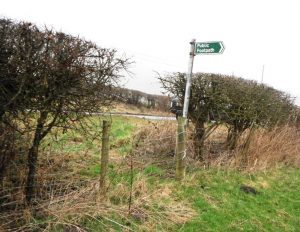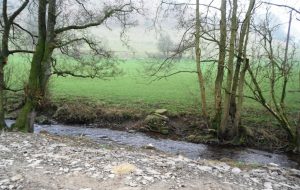Support us from £3/month
We deal with almost 1000 cases a year assisting communities, groups and individuals in protecting their local spaces and paths in all parts of England and Wales. Can you help us by joining as a member?

LM1240 Llanfihangel Nant Melan – the wire fence by the footpath sign was reported in April 1997 and has been chased regularly since but to no avail.
We have called on Powys County Council to step up its work in maintaining and promoting the county’s public-path network. The society was responding to a consultation on the council’s revised rights-of-way improvement plan (ROWIP).
Our Radnorshire representative, Peter Newman, says that much of the public-rights-of-way network in Powys is ‘dire’ and that in many communities the majority of paths are unusable, owing to wilful obstructions especially barbed-wire fences across the paths, and are unknown because they lack signposts and waymarks.
Says Peter: ‘The council claims that 40 per cent of the public rights of way were open and easy to use in 2013. Our experience is that the percentage is lower than that.’
Peter argues that the current policies set out in the ROWIP are mostly ineffective. Work is only scheduled in certain communities, known as ‘priority communities’, while other areas remain largely untouched, except where action is urgent. The society has reported obstructions in the 1990s which have still not received attention.
The society proposes that the current priority system is abandoned and substituted by a new, four-point plan, as follows.

LM1240 Llanfihangel Nant Melan – the missing bridge was also reported in April 1997 but no action has been taken to restore it.
The council should:
1 deal with complaints of problems on the path network in a timely fashion;
2 group together problems on paths in the same locality and deal with them at the same time;
3 give more support to volunteers to ensure that there is plenty of work available for them at all times;
4 take stronger action against landowners who illegally block public paths, charge the landowner when the council removes the obstruction itself, and threaten legal action where the obstruction is deliberate—word will soon get around the landowning community that the council means business.
Peter continues: ‘This will ensure that the public money put into rights of way is used more effectively. It is well known that expenditure on public paths gives excellent value for money, for our health and happiness and by bringing income to the rural economy. Such expenditure is absolutely in line with the spirit and the letter of the Well-being of Future Generations (Wales) Act 2015.
‘We recognise that Powys Council’s hard-pressed rights-of-way staff do the best they can with limited resources and we want to help them. We believe that our four-point plan will be a useful starting-point.’
